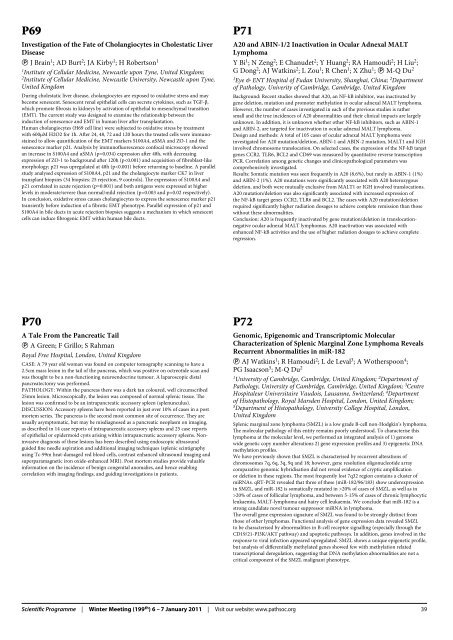Winter Meeting 2011 - The Pathological Society of Great Britain ...
Winter Meeting 2011 - The Pathological Society of Great Britain ...
Winter Meeting 2011 - The Pathological Society of Great Britain ...
You also want an ePaper? Increase the reach of your titles
YUMPU automatically turns print PDFs into web optimized ePapers that Google loves.
P69<br />
Investigation <strong>of</strong> the Fate <strong>of</strong> Cholangiocytes in Cholestatic Liver<br />
Disease<br />
P J Brain 1 ; AD Burt 2 ; JA Kirby 1 ; H Robertson 1<br />
1 Institute <strong>of</strong> Cellular Medicine, Newcastle upon Tyne, United Kingdom;<br />
2 Institute <strong>of</strong> Cellular Medicine, Newcastle University, Newcastle upon Tyne,<br />
United Kingdom<br />
During cholestatic liver disease, cholangiocytes are exposed to oxidative stress and may<br />
become senescent. Senescent renal epithelial cells can secrete cytokines, such as TGF-β,<br />
which promote fibrosis in kidneys by activation <strong>of</strong> epithelial to mesenchymal transition<br />
(EMT). <strong>The</strong> current study was designed to examine the relationship between the<br />
induction <strong>of</strong> senescence and EMT in human liver after transplantation.<br />
Human cholangiocytes (H69 cell line) were subjected to oxidative stress by treatment<br />
with 600µM H2O2 for 1h. After 24, 48, 72 and 120 hours the treated cells were immunostained<br />
to allow quantification <strong>of</strong> the EMT markers S100A4, αSMA and ZO-1 and the<br />
senescence marker p21. Analysis by immun<strong>of</strong>luorescence confocal microscopy showed<br />
an increase in S100A4 and αSMA (p=0.034) expression after 48h, with decreasing<br />
expression <strong>of</strong> ZO-1 to background after 120h (p20% <strong>of</strong> cases <strong>of</strong> follicular lymphoma, and between 5-15% <strong>of</strong> cases <strong>of</strong> chronic lymphocytic<br />
leukaemia, MALT-lymphoma and hairy cell leukaemia. We conclude that miR-182 is a<br />
strong candidate novel tumour suppressor miRNA in lymphoma.<br />
<strong>The</strong> overall gene expression signature <strong>of</strong> SMZL was found to be strongly distinct from<br />
those <strong>of</strong> other lymphomas. Functional analysis <strong>of</strong> gene expression data revealed SMZL<br />
to be characterised by abnormalities in B-cell receptor signalling (especially through the<br />
CD19/21-PI3K/AKT pathway) and apoptotic pathways. In addition, genes involved in the<br />
response to viral infection appeared upregulated. SMZL shows a unique epigenetic pr<strong>of</strong>ile,<br />
but analysis <strong>of</strong> differentially methylated genes showed few with methylation related<br />
transcriptional deregulation, suggesting that DNA methylation abnormalities are not a<br />
critical component <strong>of</strong> the SMZL malignant phenotype.<br />
Scientific Programme | <strong>Winter</strong> <strong>Meeting</strong> (199 th ) 6 – 7 January <strong>2011</strong> | Visit our website: www.pathsoc.org<br />
39













